The junction between 2 neurons Neurons The basic cellular units of nervous tissue. Each neuron consists of a body, an axon, and dendrites. Their purpose is to receive, conduct, and transmit impulses in the nervous system. Nervous System: Histology is called a synapse. The synapse allows a neuron to pass an electrical or chemical signal to another neuron or target effector cell. The neuron that sends the signal to another neuron is called the presynaptic neuron, while the neuron that receives the signal is called the postsynaptic neuron. The plasma Plasma The residual portion of blood that is left after removal of blood cells by centrifugation without prior blood coagulation. Transfusion Products membranes of the 2 neurons Neurons The basic cellular units of nervous tissue. Each neuron consists of a body, an axon, and dendrites. Their purpose is to receive, conduct, and transmit impulses in the nervous system. Nervous System: Histology are placed very close together and are held in place by synaptic adhesion Adhesion The process whereby platelets adhere to something other than platelets, e.g., collagen; basement membrane; microfibrils; or other 'foreign' surfaces. Coagulation Studies molecules that proceed from both the presynaptic and postsynaptic neurons Postsynaptic neurons Autonomic Nervous System: Anatomy. The space between the 2 neurons Neurons The basic cellular units of nervous tissue. Each neuron consists of a body, an axon, and dendrites. Their purpose is to receive, conduct, and transmit impulses in the nervous system. Nervous System: Histology is called the synaptic cleft. The molecules that mediate the interaction are called neurotransmitters.
Last updated: Dec 15, 2025
In the CNS, a synapse is a structural part of a neuron that passes an electrical or chemical signal to another neuron or to a target cell.
Neuron structure:
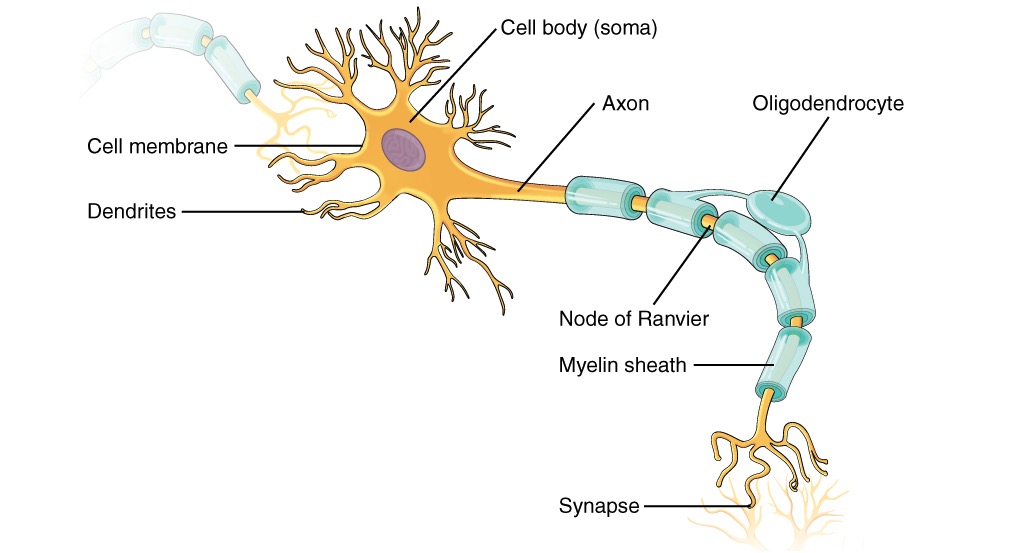
Anatomy of a neuron
Image: “Anatomy of the neuron” by Phil Schatz. License: CC BY 4.0At a synapse:
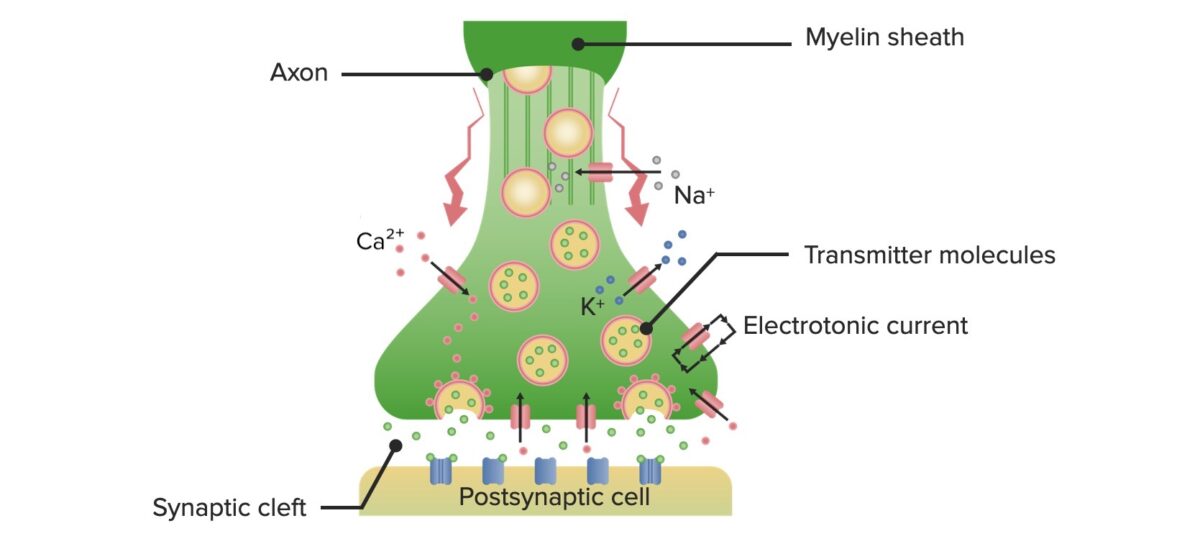
An overview of neurotransmission at the synapse
Image by Lecturio.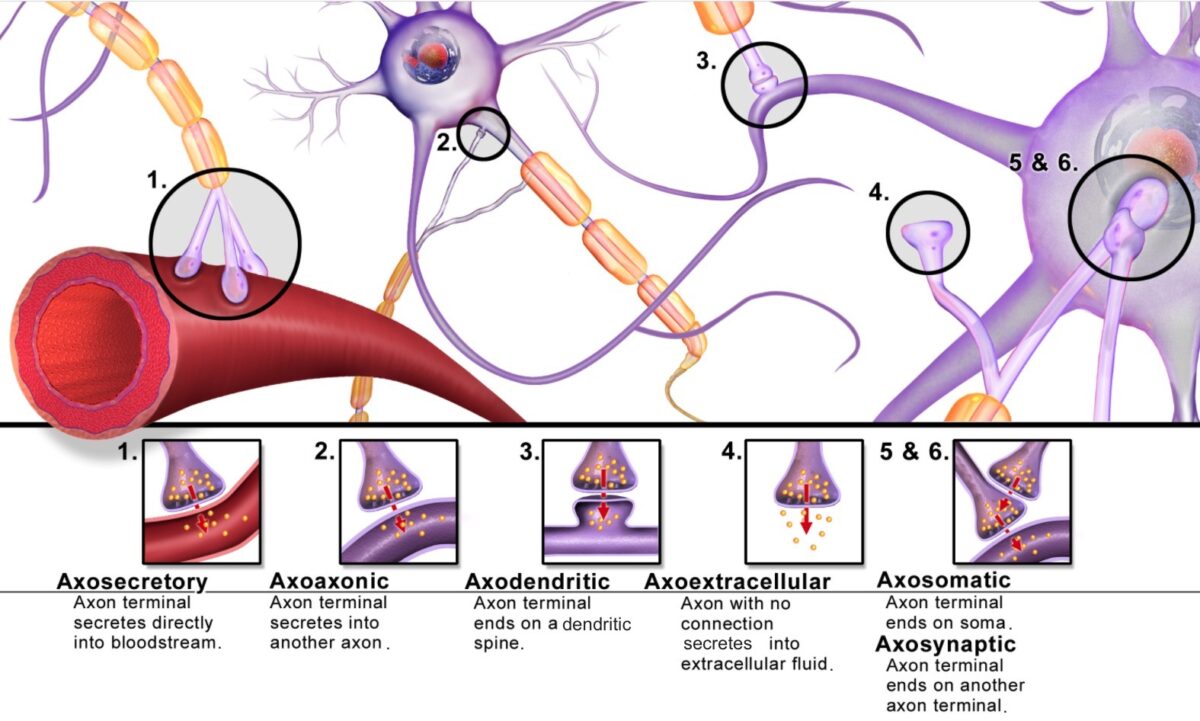
Different types of synapses by location
Image: “Synapse types” by BruceBlaus. License: CC BY 3.0Electrical synapses:
Chemical synapses:
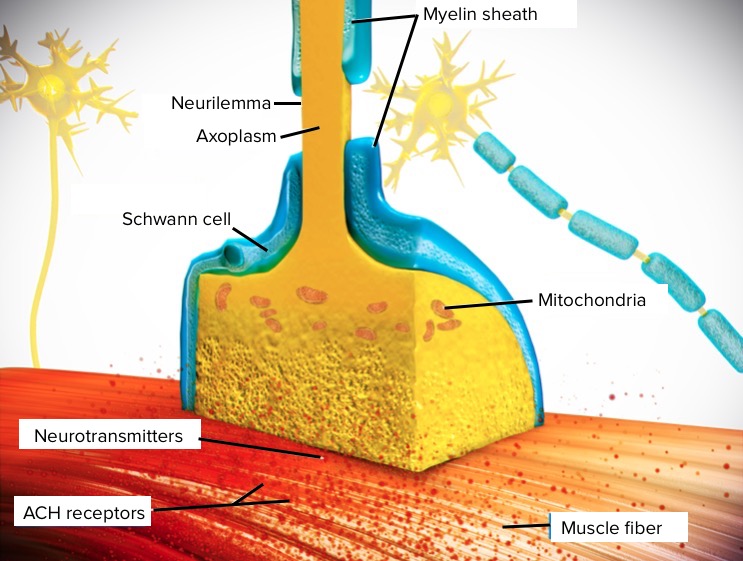
Example of chemical synapse, a neuromuscular junction
ACH: acetylcholine
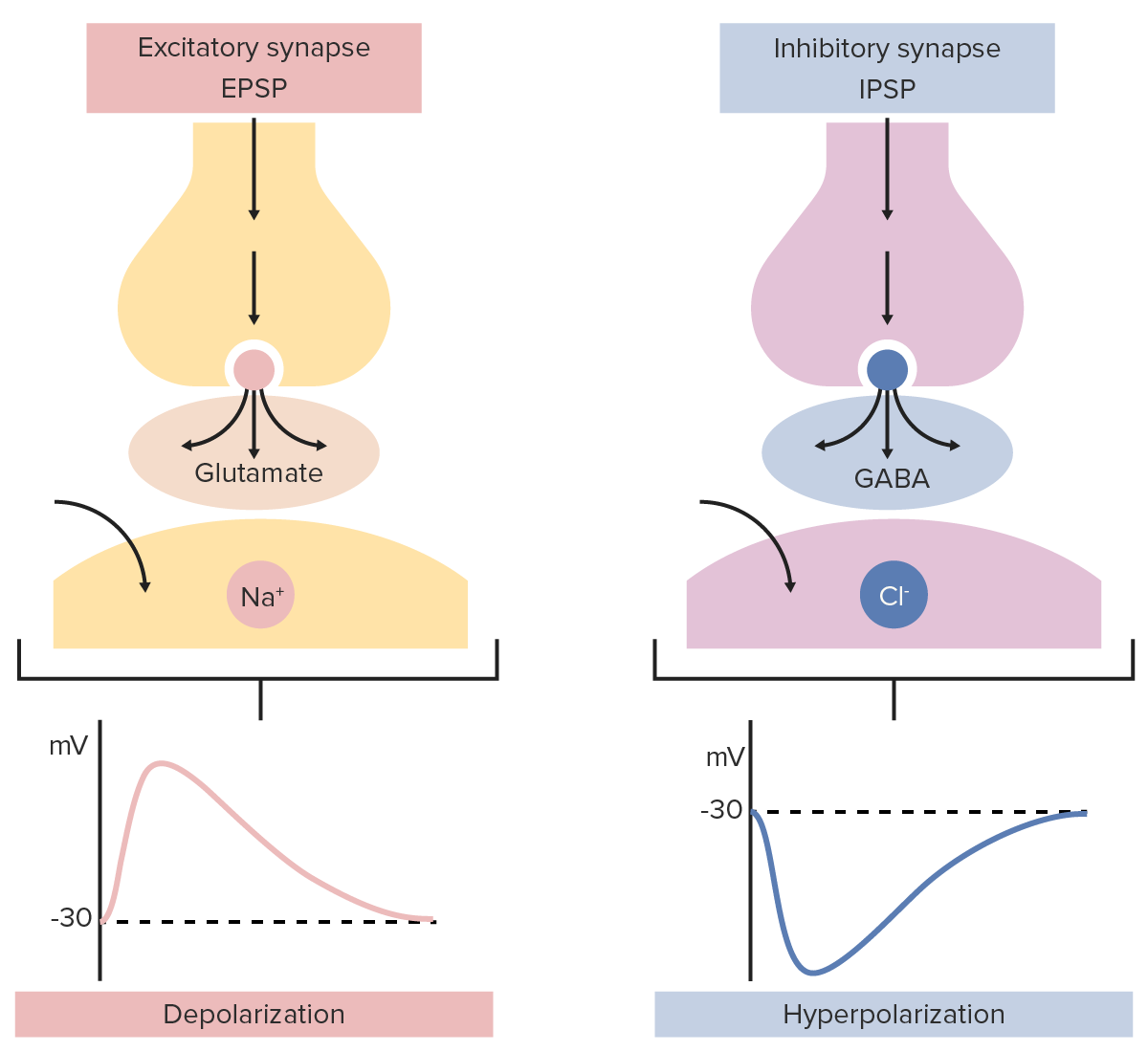
Excitatory and inhibitory synapse examples:
Left: excitatory synapse using an excitatory postsynaptic potential (EPSP) and the neurotransmitter glutamate to create a positive depolarization.
Right: inhibitory postsynaptic potential (IPSP) using the neurotransmitter GABA, causing hyperpolarization
> 500 unique neurotransmitters have been identified in humans. Neurotransmitters are:
| Neurotransmitter | Characteristics | Site of synthesis Synthesis Polymerase Chain Reaction (PCR) |
|---|---|---|
| Dopamine Dopamine One of the catecholamine neurotransmitters in the brain. It is derived from tyrosine and is the precursor to norepinephrine and epinephrine. Dopamine is a major transmitter in the extrapyramidal system of the brain, and important in regulating movement. Receptors and Neurotransmitters of the CNS | Excitatory and inhibitory | CNS: substantia nigra Substantia nigra The black substance in the ventral midbrain or the nucleus of cells containing the black substance. These cells produce dopamine, an important neurotransmitter in regulation of the sensorimotor system and mood. The dark colored melanin is a by-product of dopamine synthesis. Basal Ganglia: Anatomy, ventral tegmental area, and others |
| Norepinephrine Norepinephrine Precursor of epinephrine that is secreted by the adrenal medulla and is a widespread central and autonomic neurotransmitter. Norepinephrine is the principal transmitter of most postganglionic sympathetic fibers, and of the diffuse projection system in the brain that arises from the locus ceruleus. Receptors and Neurotransmitters of the CNS | Excitatory | CNS: locus Locus Specific regions that are mapped within a genome. Genetic loci are usually identified with a shorthand notation that indicates the chromosome number and the position of a specific band along the P or Q arm of the chromosome where they are found. For example the locus 6p21 is found within band 21 of the P-arm of chromosome 6. Many well known genetic loci are also known by common names that are associated with a genetic function or hereditary disease. Basic Terms of Genetics coeruleus, sympathetic nervous system Nervous system The nervous system is a small and complex system that consists of an intricate network of neural cells (or neurons) and even more glial cells (for support and insulation). It is divided according to its anatomical components as well as its functional characteristics. The brain and spinal cord are referred to as the central nervous system, and the branches of nerves from these structures are referred to as the peripheral nervous system. Nervous System: Anatomy, Structure, and Classification, and adrenal medulla Adrenal Medulla The inner portion of the adrenal gland. Derived from ectoderm, adrenal medulla consists mainly of chromaffin cells that produces and stores a number of neurotransmitters, mainly adrenaline (epinephrine) and norepinephrine. The activity of the adrenal medulla is regulated by the sympathetic nervous system. Adrenal Glands: Anatomy |
| Epinephrine Epinephrine The active sympathomimetic hormone from the adrenal medulla. It stimulates both the alpha- and beta- adrenergic systems, causes systemic vasoconstriction and gastrointestinal relaxation, stimulates the heart, and dilates bronchi and cerebral vessels. Sympathomimetic Drugs | Excitatory | Adrenal medulla Adrenal Medulla The inner portion of the adrenal gland. Derived from ectoderm, adrenal medulla consists mainly of chromaffin cells that produces and stores a number of neurotransmitters, mainly adrenaline (epinephrine) and norepinephrine. The activity of the adrenal medulla is regulated by the sympathetic nervous system. Adrenal Glands: Anatomy |
| Serotonin Serotonin A biochemical messenger and regulator, synthesized from the essential amino acid l-tryptophan. In humans it is found primarily in the central nervous system, gastrointestinal tract, and blood platelets. Serotonin mediates several important physiological functions including neurotransmission, gastrointestinal motility, hemostasis, and cardiovascular integrity. Receptors and Neurotransmitters of the CNS |
|
CNS: raphe Raphe Testicles: Anatomy nuclei and enterochromaffin cells |
| Histamine | Excitatory and inhibitory |
|
| Acetylcholine Acetylcholine A neurotransmitter found at neuromuscular junctions, autonomic ganglia, parasympathetic effector junctions, a subset of sympathetic effector junctions, and at many sites in the central nervous system. Receptors and Neurotransmitters of the CNS | Excitatory (usually) | Neuromuscular junctions, presympathetic synapses, and preganglionic sympathetic synapses |
| Glutamate Glutamate Derivatives of glutamic acid. Included under this heading are a broad variety of acid forms, salts, esters, and amides that contain the 2-aminopentanedioic acid structure. Synthesis of Nonessential Amino Acids |
|
CNS: almost every part of the nervous system Nervous system The nervous system is a small and complex system that consists of an intricate network of neural cells (or neurons) and even more glial cells (for support and insulation). It is divided according to its anatomical components as well as its functional characteristics. The brain and spinal cord are referred to as the central nervous system, and the branches of nerves from these structures are referred to as the peripheral nervous system. Nervous System: Anatomy, Structure, and Classification |
| GABA GABA The most common inhibitory neurotransmitter in the central nervous system. Receptors and Neurotransmitters of the CNS |
|
CNS |
| Glycine Glycine A non-essential amino acid. It is found primarily in gelatin and silk fibroin and used therapeutically as a nutrient. It is also a fast inhibitory neurotransmitter. Synthesis of Nonessential Amino Acids | Inhibitory | CNS: spinal cord Spinal cord The spinal cord is the major conduction pathway connecting the brain to the body; it is part of the CNS. In cross section, the spinal cord is divided into an H-shaped area of gray matter (consisting of synapsing neuronal cell bodies) and a surrounding area of white matter (consisting of ascending and descending tracts of myelinated axons). Spinal Cord: Anatomy, brain Brain The part of central nervous system that is contained within the skull (cranium). Arising from the neural tube, the embryonic brain is comprised of three major parts including prosencephalon (the forebrain); mesencephalon (the midbrain); and rhombencephalon (the hindbrain). The developed brain consists of cerebrum; cerebellum; and other structures in the brain stem. Nervous System: Anatomy, Structure, and Classification stem, and retina Retina The ten-layered nervous tissue membrane of the eye. It is continuous with the optic nerve and receives images of external objects and transmits visual impulses to the brain. Its outer surface is in contact with the choroid and the inner surface with the vitreous body. The outermost layer is pigmented, whereas the inner nine layers are transparent. Eye: Anatomy |
| Enkephalins Enkephalins One of the three major families of endogenous opioid peptides. The enkephalins are pentapeptides that are widespread in the central and peripheral nervous systems and in the adrenal medulla. Receptors and Neurotransmitters of the CNS | Inhibitory ( pain Pain An unpleasant sensation induced by noxious stimuli which are detected by nerve endings of nociceptive neurons. Pain: Types and Pathways) | CNS |
| Endorphins Endorphins One of the three major groups of endogenous opioid peptides. They are large peptides derived from the pro-opiomelanocortin precursor. The known members of this group are alpha-, beta-, and gamma-endorphin. The term endorphin is also sometimes used to refer to all opioid peptides, but the narrower sense is used here; opioid peptides is used for the broader group. Receptors and Neurotransmitters of the CNS | Inhibitory | CNS and PNS |
| Neurokinins Neurokinins Receptors and Neurotransmitters of the CNS | GI tract: modulate motility Motility The motor activity of the gastrointestinal tract. Gastrointestinal Motility, fluid, and electrolyte secretion Secretion Coagulation Studies | Intrinsic enteric neurons Neurons The basic cellular units of nervous tissue. Each neuron consists of a body, an axon, and dendrites. Their purpose is to receive, conduct, and transmit impulses in the nervous system. Nervous System: Histology and extrinsic primary afferent Afferent Neurons which conduct nerve impulses to the central nervous system. Nervous System: Histology nerve fibers Nerve Fibers Slender processes of neurons, including the axons and their glial envelopes (myelin sheath). Nerve fibers conduct nerve impulses to and from the central nervous system. Nervous System: Histology |
| Substance P | Modulates vasodilation Vasodilation The physiological widening of blood vessels by relaxing the underlying vascular smooth muscle. Pulmonary Hypertension Drugs, inflammation Inflammation Inflammation is a complex set of responses to infection and injury involving leukocytes as the principal cellular mediators in the body’s defense against pathogenic organisms. Inflammation is also seen as a response to tissue injury in the process of wound healing. The 5 cardinal signs of inflammation are pain, heat, redness, swelling, and loss of function. Inflammation, pain Pain An unpleasant sensation induced by noxious stimuli which are detected by nerve endings of nociceptive neurons. Pain: Types and Pathways, and the process of vomiting Vomiting The forcible expulsion of the contents of the stomach through the mouth. Hypokalemia | Intrinsic enteric neurons Neurons The basic cellular units of nervous tissue. Each neuron consists of a body, an axon, and dendrites. Their purpose is to receive, conduct, and transmit impulses in the nervous system. Nervous System: Histology and extrinsic primary afferent Afferent Neurons which conduct nerve impulses to the central nervous system. Nervous System: Histology nerve fibers Nerve Fibers Slender processes of neurons, including the axons and their glial envelopes (myelin sheath). Nerve fibers conduct nerve impulses to and from the central nervous system. Nervous System: Histology |
| Gastrin-releasing peptide gastrin-releasing peptide Neuropeptide and gut hormone that helps regulate gastric acid secretion and motor function. Once released from nerves in the antrum of the stomach, the neuropeptide stimulates release of gastrin from the gastrin-secreting cells. Gastrointestinal Neural and Hormonal Signaling | Stimulates the release of gastrin Gastrin A family of gastrointestinal peptide hormones that excite the secretion of gastric juice. They may also occur in the central nervous system where they are presumed to be neurotransmitters. Gastrointestinal Secretions from the G cells | Postganglionic fibers of the vagus nerve Vagus nerve The 10th cranial nerve. The vagus is a mixed nerve which contains somatic afferents (from skin in back of the ear and the external auditory meatus), visceral afferents (from the pharynx, larynx, thorax, and abdomen), parasympathetic efferents (to the thorax and abdomen), and efferents to striated muscle (of the larynx and pharynx). Pharynx: Anatomy |
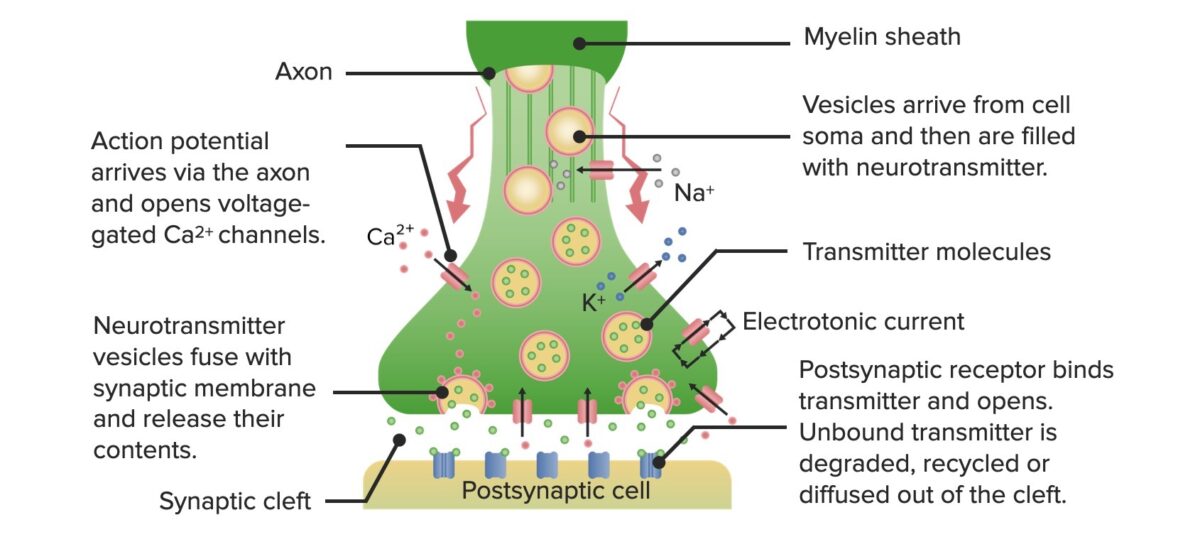
Neurotransmission actions at the synapse
Image by Lecturio.| Dopamine Dopamine One of the catecholamine neurotransmitters in the brain. It is derived from tyrosine and is the precursor to norepinephrine and epinephrine. Dopamine is a major transmitter in the extrapyramidal system of the brain, and important in regulating movement. Receptors and Neurotransmitters of the CNS | Acetylcholine Acetylcholine A neurotransmitter found at neuromuscular junctions, autonomic ganglia, parasympathetic effector junctions, a subset of sympathetic effector junctions, and at many sites in the central nervous system. Receptors and Neurotransmitters of the CNS | Norepinephrine Norepinephrine Precursor of epinephrine that is secreted by the adrenal medulla and is a widespread central and autonomic neurotransmitter. Norepinephrine is the principal transmitter of most postganglionic sympathetic fibers, and of the diffuse projection system in the brain that arises from the locus ceruleus. Receptors and Neurotransmitters of the CNS | Serotonin Serotonin A biochemical messenger and regulator, synthesized from the essential amino acid l-tryptophan. In humans it is found primarily in the central nervous system, gastrointestinal tract, and blood platelets. Serotonin mediates several important physiological functions including neurotransmission, gastrointestinal motility, hemostasis, and cardiovascular integrity. Receptors and Neurotransmitters of the CNS | GABA GABA The most common inhibitory neurotransmitter in the central nervous system. Receptors and Neurotransmitters of the CNS | |
|---|---|---|---|---|---|
| Schizophrenia Schizophrenia Schizophrenia is a chronic mental health disorder characterized by the presence of psychotic symptoms such as delusions or hallucinations. The signs and symptoms of schizophrenia are traditionally separated into 2 groups: positive (delusions, hallucinations, and disorganized speech or behavior) and negative (flat affect, avolition, anhedonia, poor attention, and alogia). Schizophrenia | ↑ | ||||
| Anxiety Anxiety Feelings or emotions of dread, apprehension, and impending disaster but not disabling as with anxiety disorders. Generalized Anxiety Disorder | ↑ | ↓ | ↓ | ||
| Depression | ↓ | ↓ | ↓ | ||
| Alzheimer disease Alzheimer disease As the most common cause of dementia, Alzheimer disease affects not only many individuals but also their families. Alzheimer disease is a progressive neurodegenerative disease that causes brain atrophy and presents with a decline in memory, cognition, and social skills. Alzheimer Disease | ↓ | ||||
| Huntington disease Huntington disease Huntington disease (HD) is a progressive neurodegenerative disorder with an autosomal dominant mode of inheritance and poor prognosis. It is caused by cytosine-adenine-guanine (CAG) trinucleotide repeats in the huntingtin gene (HTT). The most common clinical presentation in adulthood is a movement disorder known as chorea: abrupt, involuntary movements of the face, trunk, and limbs. Huntington Disease | ↑ | ↓ | ↓ | ||
| Parkinson’s disease | ↓ | ↑ | ↓ |